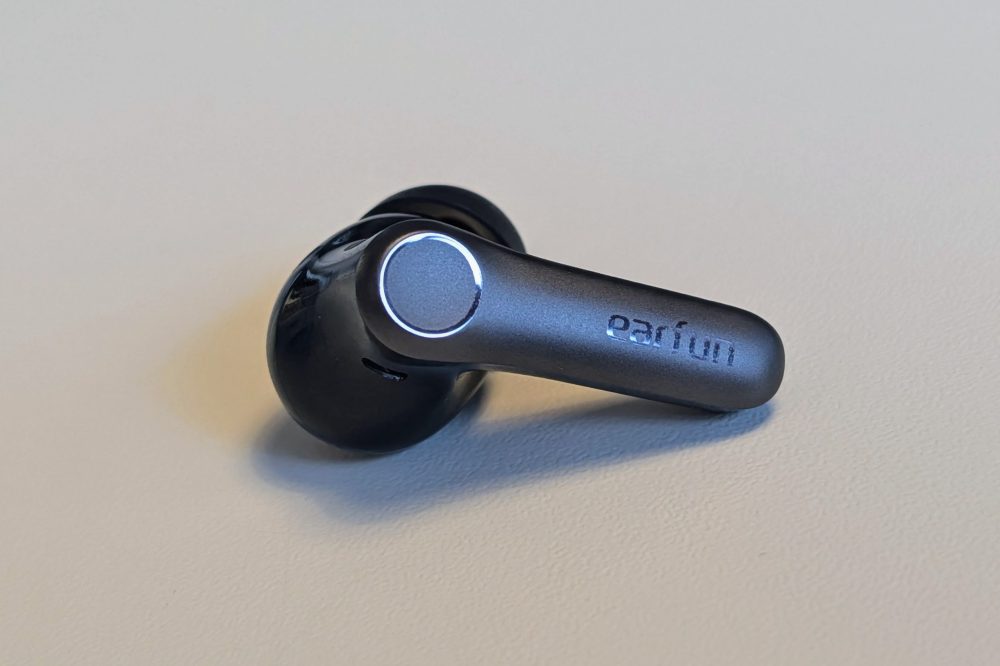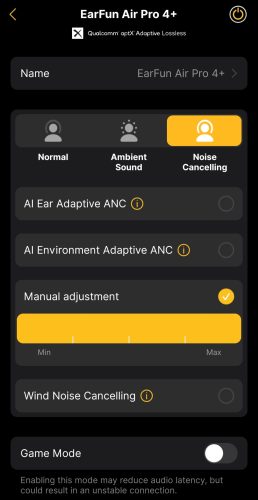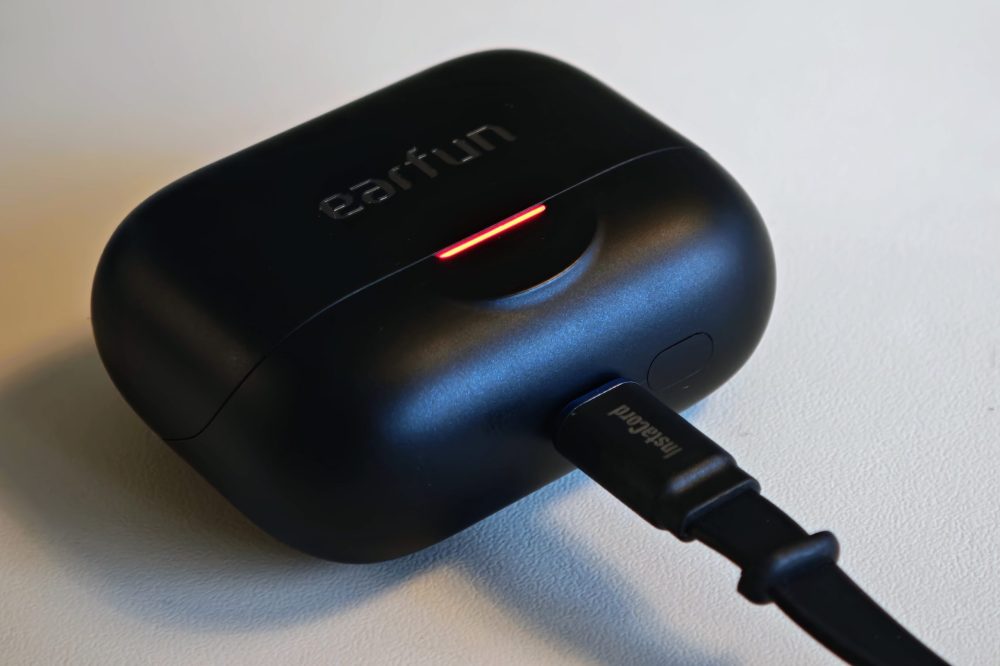TL;DR
EarFun's Air Pro 4+ earbuds pack a punch for their sub-$100 price, boasting impressive dual-driver sound with detailed highs and punchy bass, plus excellent battery life and wireless charging. While ANC shows marginal improvements and call quality suffers in noise, the comfortable fit (though potentially bulky for small ears) and stable Bluetooth 6.0 connectivity with multipoint support make them a compelling option. Still, the ambient mode remains a weak point. Read the full review to see if these pros outweigh the cons for your needs.
EarFun has become a frequent subject in our editorial office. We have previously tested a number of their products, including its predecessor EarFun Air Pro 4, and were impressed by the significant value it offered.
We now turn our attention to its successor, the EarFun Air Pro 4+. A key enhancement is a new hybrid system with dual drivers, a configuration typically found only in significantly more expensive headphones.
Similar to the EarFun Air Pro 4, its specifications are highly promising on paper: featuring comprehensive codec support, extended battery life, among other benefits. The ‘Plus’ designation naturally implies enhancements across the board. This comprehensive feature set is offered at a price point well under one hundred dollars. Does the real-world performance match these expectations? We investigate further.
Design and Comfort
Included in the package are the charging case, a short USB-C cable, and a comprehensive selection of five different sizes of silicone ear tips, now featuring a slightly oval shape. This oval design means users are somewhat limited when it comes to third-party ear tips, should they wish to purchase, for example, foam instead of silicone.

The case is matte black and has a somewhat plastic feel. While it lacks a distinctly premium aesthetic, it is functional and now supports wireless charging, which is a welcome addition. The case features a discreetly blinking red LED when charging, or blue when it is searching for a device to connect to. The earbuds support Google Fast Pair, so Android phone users will find them appear immediately upon opening the case, enabling a seamless pairing process.

The earbuds themselves retain their stem design, but a notable observation is that the earpiece that sits within the ear canal appears slightly larger and has a different shape than on the Air Pro 4. This is likely due to the integration of the new, additional “Balanced Armature” driver. While the size difference is minimal, individuals with very small ears may find the fit slightly bulky.
At the top of the stem, there is a circular touch-sensitive surface; this provides effective control for the earbuds. However, we find that a touch-sensitive stem, as seen on the Samsung Galaxy Buds 3 FE, is preferable as it minimizes unintended activations during fit adjustments.
The earbuds are now IP55-rated, an upgrade from IPX5, which means they are not only resistant to sweat and rain but also offer a degree of dust ingress protection.
Sound Quality and App

Our testing commenced with connecting the earbuds to EarFun’s app. The app remains familiar: functional, though aesthetically unrefined. It provides access to a 10-band equalizer, the ability to adjust touch controls, configure ANC, and manage devices for multipoint connectivity.

Initial listening impressions, without any adjustments, were immediately positive.
When testing the predecessor, we noted the bass could be “a bit too prominent.” This characteristic has been effectively addressed. The significant enhancement lies in its dual-driver configuration: a 10 mm dynamic driver for the bass and a dedicated “Balanced Armature” driver for the treble.
The result is a sound profile that is significantly more detailed and balanced. The bass is impressive, exhibiting both depth and punch, allowing for distinct layering in the low-frequency register. However, it is in the mid-range and treble reproduction where the earbuds truly excel. Voices are clearer, more focused, and cymbals exhibit an airiness and detailed nuance that was less apparent in the predecessor.
The sound quality, for under a hundred dollars, is highly commendable. Support for high-resolution codecs like aptX Lossless and LDAC further enhances the listening experience.
Noise Reduction (ANC) and Ambient Mode
As noted in our previous review, we expressed surprising satisfaction with the ANC on the regular Air Pro 4. The Plus model is marketed with identical ANC specifications and chip (up to 50 dB), leading us to anticipate a similar result; however, the reality is more nuanced.
In a direct comparison, the 4+ demonstrates a marginal improvement at removing persistent low-frequency rumble, such as engine noise on a bus. Conversely, it is markedly less effective at handling mid-range sounds, such as voices in an office.
A dedicated mode for wind noise reduction is significantly improved over the predecessor. Without this mode, wind noise can be substantial during activities like cycling or general outdoor use in breezy conditions. However, activating this mode effectively mitigates nearly all wind noise.
Our testing was conducted with a preview software version, during which we received 3-4 firmware upgrades. While improvements have been noted, further refinement is still possible. This suggests the ANC performance has potential for further optimization.
The ambient mode (Ambient Sound) represented the weakest aspect of the predecessor, and regrettably, this area shows no significant improvement. It still sounds unnatural, tinny, and is accompanied by a faint background hiss. It is adequate for discerning announcements at a train station, but is not suitable for extended conversations. Furthermore, the reproduction of one’s own voice often sounds muffled and artificial.
Call Quality and Connectivity
On paper, the specifications are promising, featuring six microphones and AI filtering. In quiet environments, call quality is commendable, with clear and distinct voice reproduction. However, as soon as we are in noisy environments, such as very windy conditions or near car traffic, we observe that the AI algorithm exhibits excessive aggression.
Its aggressive noise suppression attempts inadvertently clip portions of the speaker’s voice, resulting in a choppy and unnatural sound for the recipient. But just like with the ANC, this aspect holds potential for improvement through firmware updates.
The connection, now with support for Bluetooth 6.0, is exceptionally stable. The Multipoint connection, enabling simultaneous pairing with two devices, operates quickly and seamlessly, which is also appreciated. Support for LDAC in Multipoint mode is a welcome addition.
The earbuds feature “in-ear detection,” automatically pausing music when an earbud is removed and resuming playback when it is reinserted. This functionality performs reliably.
Battery Life and Charging

EarFun specifies up to 8 hours of playback with ANC enabled, and a total of 54 hours with the charging case. The predecessor achieved approximately 7 hours, representing a marginal improvement.
During our tests, we yielded just over 7 hours with ANC enabled and music at medium volume with the LDAC codec active. Disabling ANC and opting out of LDAC extends playback to over 10 hours. Battery life continues to be a standout strength for EarFun.
As mentioned earlier, the Plus model now supports wireless charging, a welcome convenience. It also features fast charging, which delivers 3 hours of playback from a mere 10-minute charge. Fully charging the earbuds in the case takes approximately 1 hour. The case requires 2 hours to charge via USB-C or a full 3.5 hours if charging wirelessly.
Conclusion
The value proposition is undeniable. The recommended price is $99, but promotions are frequent, so a street price under $80 is often attainable. For this investment, consumers receive exceptional battery life, wireless charging, commendable sound quality, broad codec support, and competent ANC.
ANC, ambient mode, and call quality are the primary factors that temper its overall rating. While certainly not poor for its price segment, it falls short of the high standard set by its other features.
EarFun sent review units for this test. Material providers have no editorial influence on our tests; we always write independently with our readers and consumers in focus.
EarFun offers senses readers to buy EarFun Air Pro 4 at a 25% discounted price using the code AP4PPR01 (i.e., approximately $75 / 750 SEK instead of around $100 / 1000 SEK, including free shipping). We at senses receive no commission or kickback for this.

